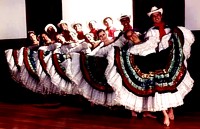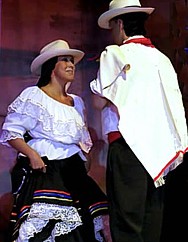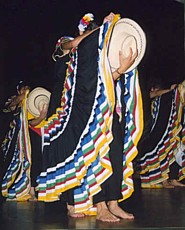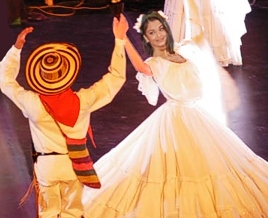





















 |
COLOMBIAN MUSIC |
||
MUSIC Traditional Colombian music can be divided into four distinct zones: The Atlantic (Caribbean) coast , the Pacific coast , the Andean region, and the Eastern Plains. Caribbean (Atlantic) music pulsates with vibrant rhythms, such as cumbia, porro and mapalé. The cumbia is mainly accompanied by an instrument called guacharaca. The music from the Pacific coast, such as the currulao with its strong use of drums, is touched by Spanish influence. The Colombian Andean music has been influenced by Spanish rhythms Among typical examples are the bambuco, pasillo guabina and torbellino, played with stringed instruments such as the tiple or guitar, as well as piano. The Andean music of Colombia
differs noticeably from that of Peru, Ecuador or Bolivia. Apart from these traditional forms, two
musical rhythms have conquered large parts of the country. These are
"la salsa" which has spread throughout the country, with
Cali considered as the capital of la salsa, and the
"vallenato", which originated in La Guajira and Cesar in the
northern part of the Caribbean coast. The vallenato rhythm is
mainly played by the vallenato accordion (buttons accordion) and other
instruments. |
00:00
To listen to the songs click on the 1- SOY COLOMBIANO Author: RAFAEL GODOY Rhythm: BAMBUCO This is one of the most beautiful and popular songs of Colombia, which should never be far from the heart of a good Colombian. Different interpretations by several artists of the above-mentioned song, can be heard. You can listen in your virtual IPOD the next 2 songs by click on their title below 2-COLOMBIA TIERRA QUERIDA 3-LA GOTA FRIA Close all the windows and stop the music before clicking on selections 2 or 3. |
|||||||||
These musical instruments are only part of the great variety that one encounters, playing different types of Colombian music. To hear the music or song in which a specific instrument is used, click on the corresponding image. Close all the windows showing instruments and stop the music before clicking on the graphic. |
Dances and typical
rythms of Colombia
Musical rhythms of the Caribbean Region CUMBIA BULLERENGUE: Its rhythm is derived from the cumbia. It is danced by women. Men accompany them with music and their singing is regulated by clapping. It differs from the cumbia in the dance choreography. MAPALE: It is of African origin and is danced chiefly on the Atlantic coast and on the banks of the Magdalena River. With its fast rhythm and constant clapping, it has a marked playful quality. MERENGUE: A native rhythm of the Dominican Republic. It is the only West Indian rhythm that competes with other international ones. It is very popular in the Caribbean region of Colombia, mainly in the Magdalena department and the surrounding area. PASEO: It is divided into two rhythms, slow and fast The latter is the most popular in vallenata music. The slow paseo is romantic, but the fast one rarely so. From time to time, it can be confused with the merengue. PORRO A rhythm originating in Caribbean folklore, that contains dancing and singing. It has variants such as the porro tapao or puya and the porro palitiao, a faster rhythm than the cumbia. According to some, it is a monotonous but joyful rhythm. In the beginning, the porro was performed on native instruments and nowadays it is played by an orchestra and by papayera bands. MAPALÉ: It is of African origin
and is danced chiefly on the Atlantic coast and on the banks of the
Magdalena River. With its fast rhythm and constant clapping, it
has a marked playful quality. GUABINA:
A typical rhythm of the Huila, Tolima, Santander and Bayacá
regions. The National Festival of guabina and
tiple, takes place at the beginning of August in Velez,
Santander, where representatives of different departments get
together. The guabina is a vocal song with danza
and torbellino rhythms and added variants of popular songs,
although there are guabinas with their own structure
PASILLO: A rhythm inspired by the Austrian waltz and the Colombian "danza". In the beginning, it was played on the piano in reception rooms. Subsequently, it became popular and started to be played on the tiple, the mandolin and the guitar, accompanied by singing. The lyrics, which are usually beautiful, have been composed by well-known poets. Among the best-known pasillos are: La gata golosa, Chaflán’, Vino tinto, Esperanza and many others. RAJALEÑA: This rhythm is the most authentic among the different musical expressions of Huila folklore. The instruments that distinguish the rajaleña from other types of music are the queco flute, the carangano, the tiple, the drum and other native instruments of the region. The rajaleña's clever lyrics express their love stories, their life experiences and the beauty of their region. SANJUANERO: Music which has come from old folklore of the so-called Tolima Grande. (Huila and Tolima) It is a mixture of bambuco and joropo and is played at the St. John and St. Peter festivals. This rhythm is joyful and fast and its dance represents the conquest of love, which begins with a flirt, is followed by infatuation, and ends with the symbol of marriage. BUNDE: Tune of the Pacific coastal region that also exists in Andean folklore. It consists of a mixture of rhythms; structured guabina, torbellino and bambuco. The best known is the Bunde Tolimense by the composer Alberto Castilla TORBELLINO: Rhythm from Boyacá, Cundinamarca and Santander folklore that is heard during pilgrimages, dances, local holidays and travels. The peasants express their feelings with their music which is accompanied by songs and dances. SALSA: A Cuban native rhythm introduced to Colombia through Barranquilla. At the end of the sixties, some Puerto Rican musicians played the rhythm at the Cali Fair and the people of that city adopted the rhythm, the city thus becoming "The World Capital of Salsa". |
Musical Rhythms of the Pacific
Coast Region of Colombia BUNDE: Musical tune from the Pacific seaboard. It is of African origin and its name comes from the word “wunde” from Sierra Leone. It also exists in Andean folklore with a mixture of rhythms such as structured guabina, torbellino and bambuco. The best known is the bunde tolimense composed by A. Castilla. CONTRADANZA: It is a popular dance of the south region of the Pacific coast. It is used in dance shows to illustrate a typical national dance, as a result of the striking colours of the costumes, its elegance and the mobility of the dancers CURRULAO: It is the best-known rhythm from the folklore of the Pacific region. It consists of dancing and singing, accompanied by music played typically with instruments such as the native marimba, the conunos, the bass drum, the side drum and the cuatro guasas or tubular rattle. It has two varieties: the juga and the bereju. MAKERULE:
Music of Choco folklore. It resembles an Andean dance. The
slowness of the dance shows its noble ancestry. Some people
from the region say that its name came from the surname, "Mac
Duller ", a man who had a bakery in the town of Andagoya,
department of Choco. GALERON: It is a variation of joropo with a similar structure. It is the oldest rhythm, dance and song of the plains area. It is heard a lot while cowboys are working and is frequently played during the plainsmen festivals. One of the best-known galerones is called Galeron Llanero. PASAJE: It is a rhythmic and slow variety of joropo. The lyrics of its songs are usually descriptive. Other secondary rhythms Chocó: Pregón, Polka, Mazurka, Jota Chocoana, Calypso, Tamborito Chocoano, Abozado, Aguacorta, Agualarga and Bambara. Southern Pacific
Region: (songs) Pango, Andarele, La Madrugada, Tiguarandó
and Saporrondó. San Andrés and Providencia: Scottish Cuadrillas, Cotillón and Calypso. Diverse rhythms VIDEOS OF REGIONAL DANCES AND COLOMBIAN MUSIC Musical Instruments The musical instruments which are used to play the different types of Colombian music are: MANDOLIN: A stringed instrument plucked with a plectrum. It is usually accompanied by the tiple and the guitar BOMBARDINO: It
is a brass wind instrument, otherwise known as the tuba or euphonium,
played with the clarinet. BASS DRUM OR
TAMBORA: A drum from the Pacific seaboard, whose cylindrical
body is made from a balsa tree trunk. CAPADOR: A wind
instrument made with pipes of fine hollow canes of different sizes.
The name, capador, is only used in Cundinamarca, Tolima and Huila. KARANGANO: An instrument from Huila and Tolima departments, made of bamboo. CHIRIMÍA: A wooden Instrument similar to a clarinet. It has almost disappeared because it is very difficult to play. CLARINET: An instrument of European origin, frequently used in Choco department . CUARTO: A
stringed instrument mainly used on the eastern plains. CUNUNO: A conical form of drum, from the Pacific coastal region. ESTERILLA : A wind instrument with twelve pipes made of cane, bound together by a fibrous string. REED FLUTE : (Flauta de
Carrizo) MILLO FLUTE : This wind instrument is a kind of flute made of cane from millo. It is the essential instrument for playing the cumbia music of the Atlantic coastal region. GUACHE: A
percussion instrument used to play cumbia music, along with the
guacharaca, millo flute, brass drum and maracas. GUASÁ: A typical bamboo percussion instrument from the Pacific seaboard. It resembles a maraca without the handle, and is of tubular form with vegetable seeds and stones inside. It is played on the diagonal. MARIMBA OF CHONTA: A marimba made from the chonta palm tree It is typical of the Pacific coast. REQUINTO: A wooden stringed instrument, similar to a small tiple, with twelve metal strings divided into four groups of three strings each. RONDADOR: A wind instrument made of different-sized pipes of fine hollow canes bound together by a fibrous string. ZAMBOMBA: A type of drum. This instrument is a gourd, cut in half and covered with an animal skin. There is a hole in the middle which holds a cedar stick. It is typical of the departments of Santander, Huila and Tolima . It accompanies guabina and torbellino music. |
||||||||
|